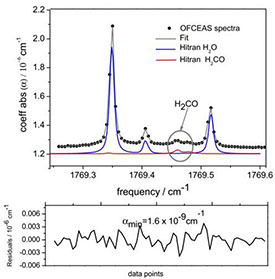- Share
- Share on Facebook
- Share on X
- Share on LinkedIn
QCL-OFCEAS Instrument Performance :
The LAME team of LIPhy has demonstrated the good suitability of QCL lasers for the OF-CEAS method. Several instruments have been developed with a typical sensitivity of the order of 10-9/cm-1 in absorption unit for an acquisition time of 1s. Combined with a small volume of gas analyzed (20 cm3) and a short response time (1s), this very high sensitivity is exploited for various fields of application as illustrated by the recent developments of OF-CEAS spectrometers designed with QCL operating at room temperature:
- 4.30µm : Measurement of the CO2 isotope ratio for the 13C carbon isotope, 17O containing and doubly substituted minority isotopes (16O13C18O). This instrument is developed for the analysis of air bubbles trapped in ice within the Subglacior project. The sensitivity on the isotope ratio measurement is of the order of 0.1 ‰ in a few minutes.
- 4.46µm : N2O, 546 and 456 isotope ratio measurement for atmospheric chemistry (first demonstration of QCL coupling in an optical cavity, [Maisons,2010])
- 5.26µm : NO for breath analysis, atmospheric chemistry and outdoor air quality monitoring. Detection limit: < 100pptv in 10s.
- 5.65µm : HCHO (formaldehyde) for plasma analysis and indoor air quality monitoring. Detection limit: 60 pptv at 10 Hz, with potentially formic acid at the ppb level [Gorrotxategi-Carbajo, 2013].

Spectre OF-CEAS (points noirs) enregistré en 100 ms avec de l’air ambiant. L’ajustement de la simulation, réalisé en temps réel, est tracé en gris. On distingue trois raies d’absorption de l’eau et un doublet faible de H2CO centré à 1769.46 cm-1. Une simulation tirée de la base de données HITRAN est tracée en rouge et bleu (décalé pour plus de clarté). La courbe inférieure montre les résidus de l’ajustement [Gorrotxategi-Carbajo, 2013].
Collaborations :
- Alcatel Thales III-V lab, Palaiseau, France ;
- Laboratoire de Physique des Plasmas (LPP), Ecole Polytechnique, Palaiseau, France ;
- Laboratoire de Glaciologie et Geophysique de l’Environnement (LGGE), Grenoble, France ;
- Laboratoire TIMC-IMAG (CHU de Grenoble), équipe PRETA, Grenoble, France.
Actors
Daniele ROMANINI
Irène VENTRILLARD
- Share
- Share on Facebook
- Share on X
- Share on LinkedIn